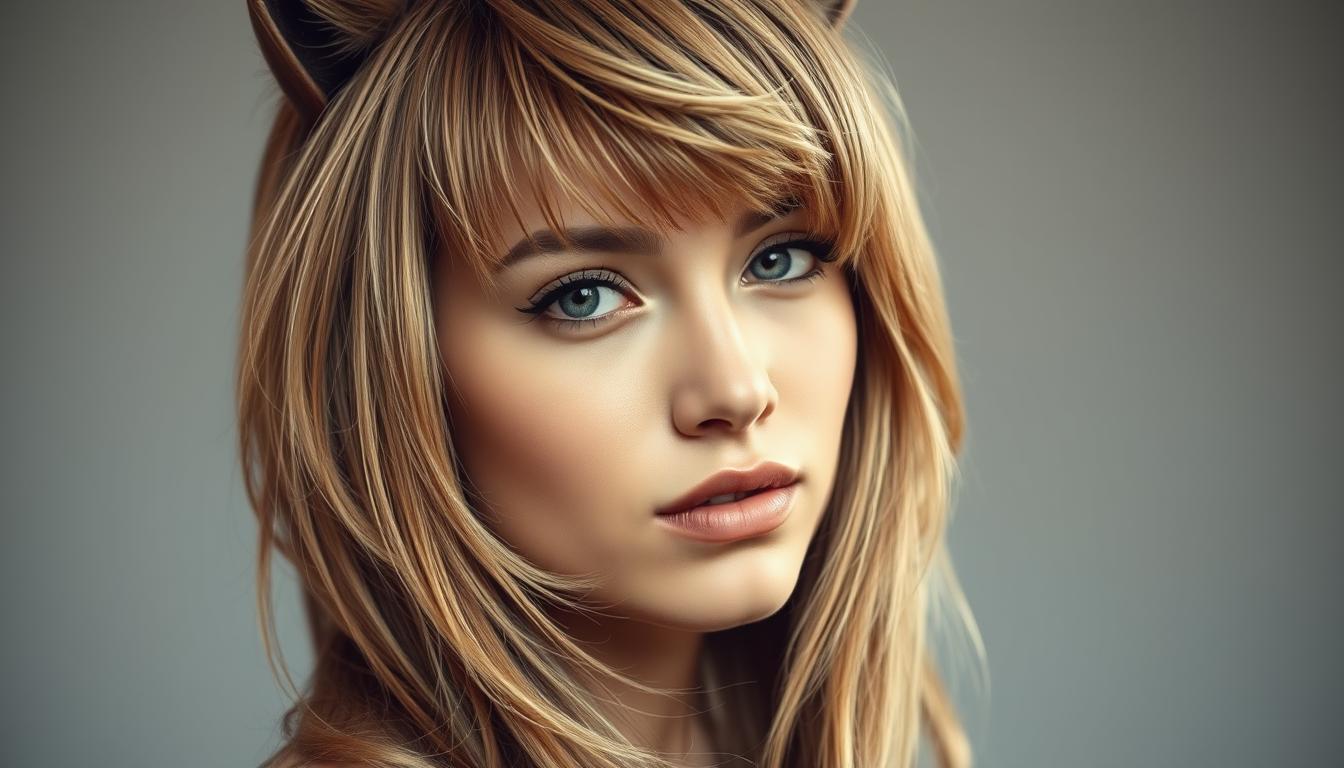
What if your next hairstyle could effortlessly balance chaos and sophistication while suiting nearly every hair type? The answer lies in the viral phenomenon taking over social media feeds and salon chairs nationwide.
This bold look merges the rebellious spirit of a mullet with the textured layers of a shag. Born from Gen Z’s love for nostalgic trends, it’s racked up over 1.2 billion TikTok views since influencers and celebrities debuted their wild, wispy versions. Its magic? Creating volume and movement without daily styling marathons.
Perfect for straight, wavy, or curly locks, this style adapts like a chameleon. Face-framing layers soften angles, while choppy ends add playful edge. Best of all: it grows out gracefully, making salon trips less frequent.
Key Takeaways
- Combines elements of mullet and shag styles for maximum texture
- Works with all hair types and face shapes
- Requires minimal daily maintenance
- Gained popularity through TikTok and celebrity influence
- Enhances natural volume and movement
- Easily customizable through layering techniques
Understanding the Wolf Cut
Ever wondered how a hairstyle becomes a global sensation? This look combines rebellious energy with wearable flair, creating a style that feels both fresh and nostalgic. Let’s explore its roots and what sets it apart from similar trends.
Origins and Cultural Evolution
The style first emerged in Asian pop culture during the 2010s. K-pop idols and Japanese anime characters rocked layered, textured looks that balanced edge with softness. By 2020, platforms like TikTok transformed it into a Western phenomenon. E-boys and e-girls embraced its messy charm, pushing it into mainstream fashion.
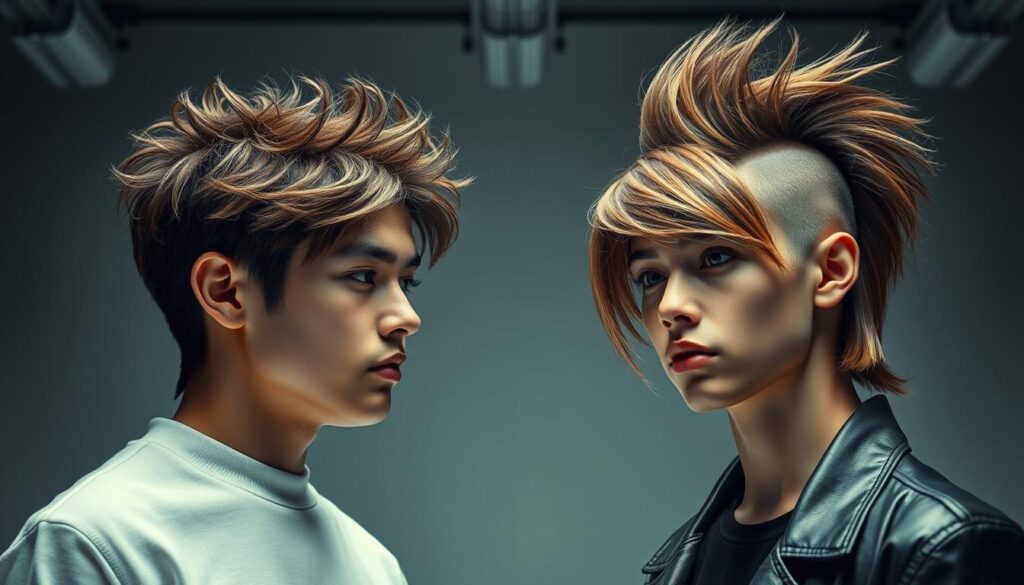
Differences Between the Wolf Cut and Mullet
Though often confused, these two styles have clear contrasts. Both feature shorter front sections and longer backs, but that’s where similarities end. The modern version uses blended layers for a lived-in feel, while its predecessor prioritizes sharp contrasts.
| Feature | Wolf Cut | Mullet |
|---|---|---|
| Layers | Multiple textured layers | Minimal layering |
| Structure | Messy, blended transition | Clear front/back division |
| Styling Effort | Air-dries naturally | Requires product |
The table shows why this style works for daily wear. Its adaptability makes it ideal for those wanting edge without high maintenance. Whether you’re into grunge or minimalism, there’s a version that fits your vibe.
Types and Variations of the Wolf Cut
The secret to nailing this trend? Choosing the right variation for your unique hair story. Like denim jackets or leather boots, this style morphs to match personal preferences while keeping its rebellious core. Let’s explore how length, texture, and cultural influences create distinct personalities within the same trend.
Classic, Long, and Short Versions
Classic versions thrive on contrast. Thick layers at the crown gradually soften into wispy ends, perfect for adding movement to wavy or straight hair. It’s that “just rolled out of bed” charm with intentional structure.
Prefer drama? Long interpretations maintain feathery layers while showcasing flowing length. The extra inches create versatile styling options—think half-updos or beachy waves. Short adaptations pack equal punch. Razor-cut layers add edge without sacrificing professionalism, ideal for busy schedules.
Unique Styles: Curly, Straight, and Korean Influences
Curly textures shine in specialized versions. Stylists sculpt ringlets into defined shapes that bounce with life. “The key is balancing volume with shape,” says LA stylist Mara Lee. “We remove bulk without flattening natural curl patterns.”
Korean-inspired takes offer softer edges. Gentle layering replaces choppy ends, often paired with honey-toned balayage or ash-brown hues. Straight-haired versions rely on strategic slicing to create illusionary depth. Whether bleached platinum or jet-black, these styles prove sleek hair can have wild attitude.
Styling the Wolf Cut: A Step-by-Step Guide
Transform your morning routine into a breeze with these expert-approved techniques. The key lies in enhancing what your hair naturally does best while adding strategic definition.
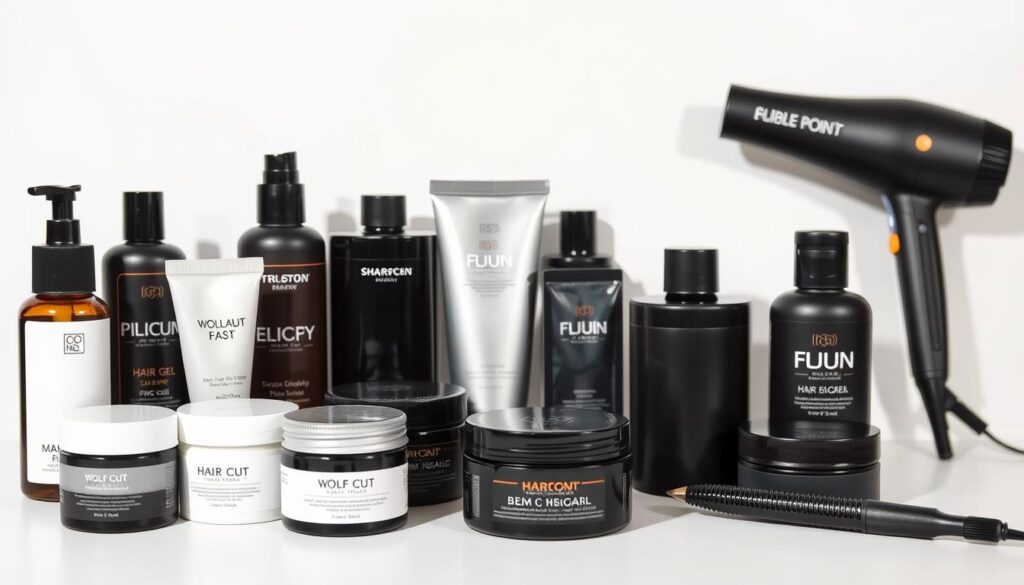
Essential Tools and Products
Build your styling arsenal with these multitaskers:
| Product Type | Best For | Pro Tip |
|---|---|---|
| Sea salt spray | Enhancing natural waves | Shake bottle before spritzing |
| Texturizing powder | Root volume boost | Tap onto roots, not ends |
| Light-hold spray | All-day movement | Hold 12″ from hair |
Creating Texture and Volume
Start with damp hair and a palm-sized amount of leave-in conditioner. Flip your head upside down while blow-drying with a diffuser to maximize bounce. Pro trick: Let hair cool completely before adding products.
For that signature lived-in look, scrunch texturizing spray into mid-lengths. Avoid over-saturating roots – you want separation, not stiffness. Finish with a single spritz of flexible-hold hairspray to lock in movement without crunch.
Choosing the Right Wolf Cut for Your Face Shape
Your face shape holds the secret to unlocking your most flattering style. This haircut acts like a personalized filter, enhancing your natural features through strategic layering and fringe placement.
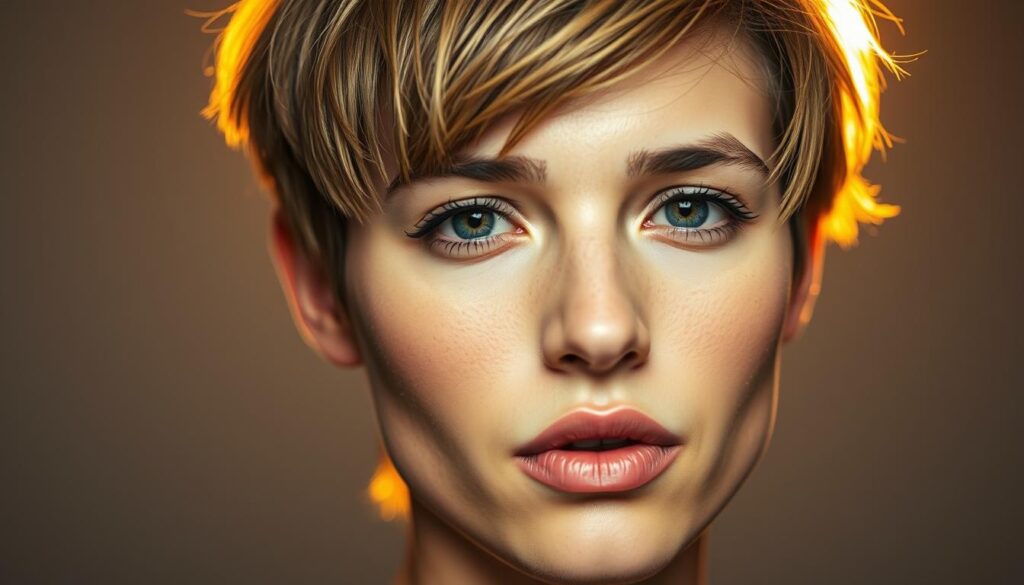
Face Framing Secrets and Bangs Magic
Heart-shaped faces thrive with wispy layers that add fullness near the jawline. Soft curtain bangs balance a wider forehead, creating harmony between upper and lower features. For oval shapes, nearly any variation works—textured layers maintain structure without overwhelming balanced proportions.
Round faces gain definition through side-swept fringe that creates diagonal lines. Longer face-framing pieces add vertical emphasis, while cropped layers at the crown lift flat areas. Rectangular or square shapes benefit from blended curtain bangs that soften angular jawlines with feathery movement.
Stylists often recommend these adjustments:
- Wider faces: focus volume at the crown
- Narrow chins: add wispy layers below cheekbones
- Strong jawlines: use curtain bangs to redirect attention upward
“The right fringe placement can redefine your entire silhouette,” explains celebrity stylist Lorna Parker. Whether you choose face-framing layers or soft bangs, this style adapts to highlight your unique bone structure effortlessly.
Optimizing Your Look for Different Hair Types
Unlock your hair’s full potential by tailoring this trend to your natural texture. The magic happens when you enhance what you already have rather than fight against it. Let’s explore how to make this style sing across various hair types.
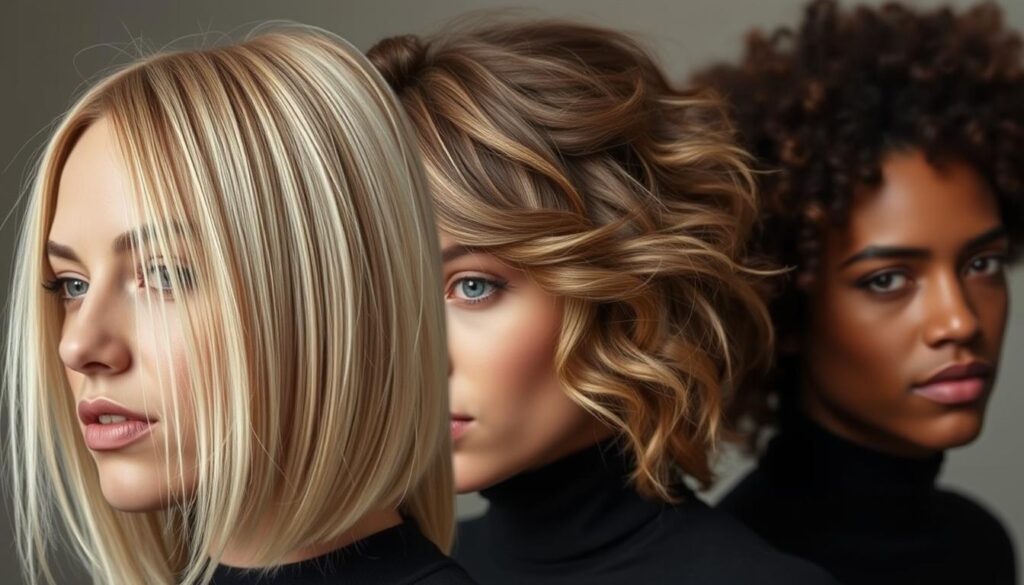
Best Practices for Curly, Wavy, and Straight Hair
Curly textures become showstoppers with layered shaping. The right blend of long and short layers gives ringlets room to bounce while maintaining structure. A curl-defining cream keeps frizz at bay without weighing down movement.
Wavy hair thrives with this style’s built-in volume boost. Light texturizing sprays enhance natural patterns, creating that coveted “lived-in” look. For those with pin-straight strands, try soft bends using a flat iron on mid-lengths. This adds dimension without overpowering sleekness.
Fine hair gets a major upgrade through strategic layering. As stylist Jenna Cole notes: “The key is removing bulk where it drags hair down while keeping enough length for movement.” Pair with a root-lifting spray for all-day lift, especially if opting for choppy layers near the crown.
Three universal rules apply:
- Use products matching your hair’s density
- Embrace air-drying when possible
- Schedule trims every 8-10 weeks
Whether your strands spiral like corkscrews or fall like silk, this style adapts beautifully. The secret lies in working with your hair’s natural personality rather than forcing a new one.
Essential Maintenance and Trimming Tips
Maintaining that perfect balance between wild and polished starts with smart upkeep. This layered style thrives on strategic care that preserves its shape while letting its natural texture shine through.
Keeping Layers and Volume in Check
Your style’s magic lies in its dimensional structure. As strands grow, layers can lose their definition. Book salon visits every 6-10 weeks based on your hair’s growth speed – shorter styles need more frequent attention.
Daily brushing prevents matting while enhancing movement. Use a wide-tooth comb starting from ends:
- Detangle gently to protect wispy layers
- Flip hair upside down for instant root lift
- Finish with a spritz of texturizing mist
“The goal isn’t perfection – it’s maintaining intentional chaos,” says stylist Tori Ramos. “We trim just enough to keep proportions balanced without losing that lived-in edge.”
Routine Care and Professional Trims
Between salon visits, focus on preserving your hair’s health. Deep-condition weekly to combat dryness from styling products. Air-dry whenever possible to maintain natural wave patterns.
| Care Aspect | Frequency | Benefit |
|---|---|---|
| End trims | 6-10 weeks | Prevents split ends |
| Scalp massage | Daily | Boosts volume |
| Clarifying wash | Monthly | Removes product buildup |
Schedule consultations with your stylist to adjust layer lengths as your hair evolves. This proactive approach keeps your look fresh while honoring its original spirit.
Styling Products to Enhance Your Wolf Cut
Mastering your signature look starts with the right toolkit. Strategic product choices preserve that artfully messy vibe while protecting your strands from styling stress. Let’s break down the essentials that keep layers bouncing and ends healthy.
Sea Salt Spray, Texturizers, and Leave-In Conditioners
Sea salt spray creates instant beachy texture. Spritz onto damp hair and scrunch for natural waves. Pair with a lightweight leave-in conditioner like OI All In One Milk to prevent dryness.
Texturizing powders add grit without stiffness. Tap This Is A Dry Texturizer onto roots for lift that lasts all day. Curly textures benefit from moisturizing mousse to define coils while reducing frizz.
Heat Protection and Finishing Sprays
Always shield your style before heat styling. This is a Blow Dry Primer forms an invisible barrier against flat iron damage. For final touches, medium-hold sprays lock in movement without crunch.
| Product Type | Purpose | Application Tip |
|---|---|---|
| Sea salt spray | Enhances natural wave pattern | Apply to damp hair |
| Texturizing powder | Boosts root volume | Focus on crown area |
| Leave-in conditioner | Prevents split ends | Comb through mid-lengths |
| Heat protection | Shields from styling tools | Spray before blow-drying |
“The best products work with your hair’s natural personality,” notes stylist Marco Perez. Dry shampoo absorbs oil between washes while adding body – perfect for refreshing day-old texture.
Match formulas to your hair type. Fine strands need feather-light sprays, while thick hair handles richer creams. With these essentials, your style stays effortlessly cool between salon visits.
Trends, Celebrity Endorsements, and Social Media Impact on the Wolf Cut
The digital age has rewritten the rules of beauty trends through screens and hashtags. Platforms like TikTok became virtual runways where styles gain momentum overnight, reshaping how we discover and adopt new looks.
Platform Power and Cultural Crossovers
Billie Eilish’s neon-tipped version and Miley Cyrus’s tousled layers turned this style into a celebrity signature. Their transformations sparked millions of DIY attempts, with TikTok tutorials racking up 12.7 million posts under #WolfCutJourney.
K-pop’s influence adds polished flair to the trend. Groups like TXT and Blackpink showcase sleek variations with blended layers – proof that edge can coexist with sophistication. This cultural fusion keeps the style fresh across continents.
“Social media turns hairstyles into living art – constantly evolving through user creativity,” notes trend analyst Clara Shin.
| Platform | Role | Impact |
|---|---|---|
| TikTok | Trend acceleration | 1.2B+ views |
| Style inspiration | Professional stylist showcases | |
| K-pop media | Cultural adaptation | Refined, wearable versions |
The rise of e-boys and e-girls created perfect conditions for this style’s Western takeover. Its grunge-meets-glam vibe aligns with their aesthetic, while the low-maintenance appeal works for busy creators. For those exploring related edgy styles, the fade mullet offers complementary texture dynamics.
Three factors keep this trend thriving:
- Celebrity transformations validate its versatility
- Platform algorithms amplify reach
- User-generated content encourages personalization
From Seoul salon videos to Texas high school makeovers, this hairstyle proves cultural boundaries don’t apply to great style. Its digital lifecycle ensures endless reinvention – what starts as a celebrity statement becomes everyone’s canvas.
Conclusion
Ready to unleash your inner trendsetter? This hairstyle’s magic lies in its chameleon-like adaptability. Whether you crave messy-bedhead charm or polished edge, it molds to your lifestyle while requiring minimal daily effort.
Social media’s favorite look isn’t just a passing phase—it’s a smart choice for real life. The layered structure works overtime to enhance natural movement, giving fine strands a volume boost and taming thick manes. Best part? It grows out beautifully, saving you constant salon trips.
Pro tip: Bring reference photos to your stylist showing both front and back angles. This ensures your version highlights your best features while maintaining that signature lived-in texture. Pair with light-hold products to keep hair bouncing freely all day.
From TikTok tutorials to red carpet moments, this style proves rebellion and sophistication can coexist. Its endless customization options mean you’re not just following a trend—you’re creating a look that’s unmistakably you. Time to rock those layers with confidence!
